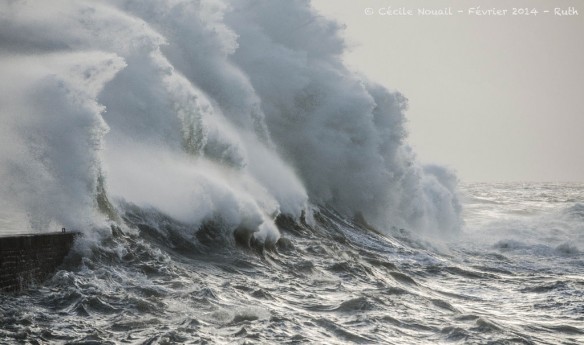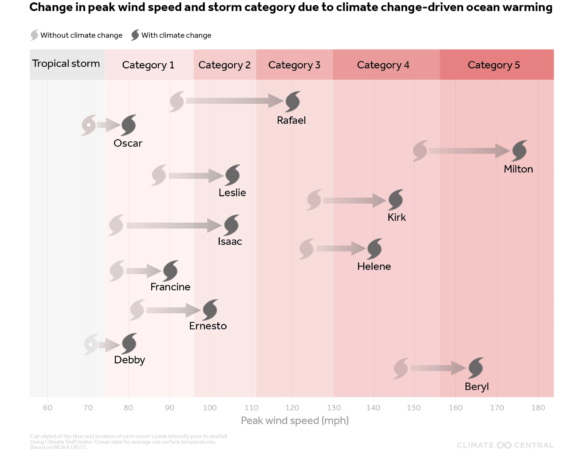
After storms Dirk, Petra, Qumaira, Ruth storm was the latest of the series of Atlantic storms battering Brittany’s coast, February 8th, 2014. Photo source: ©© Cecile Nouail
By NOAA;
A report released today investigates the causes of a wide variety of extreme weather and climate events from around the world in 2013.
Published by the Bulletin of the American Meteorological Society, “Explaining Extreme Events of 2013 from a Climate Perspective” addresses the causes of 16 individual extreme events that occurred on four continents in 2013. NOAA scientists served as three of the four lead editors on the report.
Of the five heat waves studied in the report, human-caused climate change-primarily through the burning of fossil fuels-was found to have clearly increased the severity and likelihood of those events. On the other hand, for other events examined like droughts, heavy rain events, and storms, fingerprinting the influence of human activity was more challenging. The influence of human-caused climate change on these kinds of events was sometimes evident, but often less clear, suggesting natural factors played a far more dominant role.
“This annual report contributes to a growing field of science which helps communities, businesses and nations alike understand the impacts of natural and human-caused climate change,” said Thomas R. Karl, L.H.D., director of NOAA’s National Climatic Data Center. “The science remains challenging, but the environmental intelligence the report yields to decision makers is invaluable and the demand is ever-growing.”
Confidence in the role of climate change about any one event is increased when multiple groups using independent methods come to similar conclusions. For example, in this report, five independent research teams looked at specific factors related to the record heat in Australia in 2013. Each team consistently found that human-caused climate change increased the likelihood and severity of that event. However, for the California drought, which was investigated by three teams from the United States, human factors were found not to have influenced the lack of rainfall. One team found evidence that atmospheric pressure patterns increased due to human causes, but the influence on the California drought remains uncertain.
When human influence for an event cannot be conclusively identified with the scientific tools available today, this means that if there is a human contribution, it cannot be distinguished from natural climate variability.
“There is great scientific value in having multiple studies analyze the same extreme event to determine the underlying factors that may have influenced it,” said Stephanie C. Herring, Ph.D., lead editor for the report at NOAA’s National Climatic Data Center. “Results from this report not only add to our body of knowledge about what drives extreme events, but what the odds are of these events happening again-and to what severity.”
Key findings include:
U.S. drought:
- Three independent studies, which examined Pacific sea surface temperatures and atmospheric anomalies, did not find conclusive evidence for the impact of human-caused climate change on the ongoing rainfall deficit in California. One paper found evidence that atmospheric pressure patterns increased due to human causes, but the influence on the California drought remains uncertain.
U.S. rainfall events:
- In examining pre-industrial and modern-day Colorado rainfall events, a study using a single model found that the probability of another extreme 5-day rainfall, like the one that caused widespread flooding in Boulder, is estimated to have decreased because of human-caused climate change. However, the study notes that additional research using more models is needed.
- 2013 U.S. seasonal precipitation extremes are primarily attributed to natural variability but with some evidence for human influences on the climate having increased the likelihood of such extremes.
U.S. storm:
- A blizzard that struck South Dakota in October was unusually strong for early autumn, but not unprecedented in terms of atmospheric pressure. But there is evidence at present to suggest early autumn extreme snowfall events in western South Dakota are less likely to occur as a result of human-caused climate change.
Australian and New Zealand heat waves:
- In running multiple global climate models, five independent studies all pointed toward human influence having a substantial increase in the likelihood and severity of the record 2013 temperatures in Australia.
- For New Zealand, model runs show human-caused climate change caused meteorological conditions that were more favorable for drought in 2013.
Asian heat waves & extreme precipitation:
- Japan, Korea and China all experienced extremely hot summers in 2013. Studies of these events concluded that human-caused climate change made these heat waves more likely.
- With an early arrival of monsoon-like atmospheric circulation in June, the heavy precipitation that occurred in northern India was a once-in-a-century event; however, analyses of observed and simulated June precipitation provide evidence that human-caused climate change has increased the likelihood of such an event.
European events:
- In studying the extreme cold UK spring, for which an extreme, naturally occurring North Atlantic Oscillation was found to have been the major factor, long-term warming due to human-caused climate change has made such a severe cold 30 times less likely.
- Along with natural variability of North Atlantic sea surface temperatures, human-caused climate change played a substantial part in Western Europe’s 2013 hot and dry summer.
- Winter 2013 was southern Europe’s second wettest. Despite this precipitation extreme, no evidence of human-caused climate change could be found through modeling efforts.
- Through model- and observation-based analyses, no evidence was found that human-caused climate change made the heavy precipitation of spring 2013 in the upper Danube and Elbe basins more likely.
- Cyclone Christian, a strong storm in October 2013 over northern Germany and Southern Denmark, was part of the multi-decadal variability that has increased storminess during recent decades.
- Although a rare weather event, an examination of multiple datasets concluded natural climatic variability was found to be a main driver of the Pyrenees Snow Fall in January to June 2013.
The report was edited by Herring, along with Martin P. Hoerling, NOAA’s Earth System Research Laboratory; Thomas Peterson, NOAA’s National Climatic Data Center, and Peter A. Stott, UK Met Office Hadley Centre and written by 92 scientists from 14 countries.









